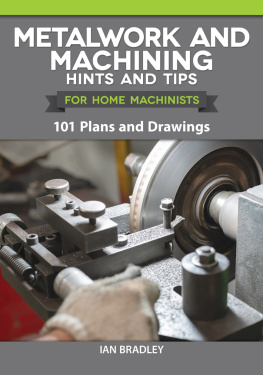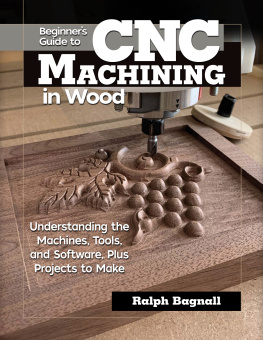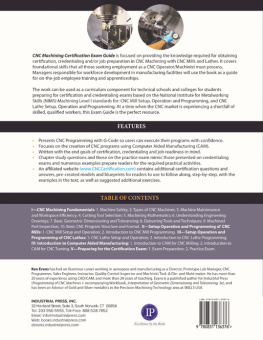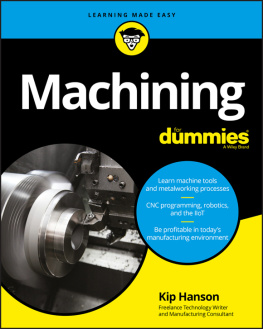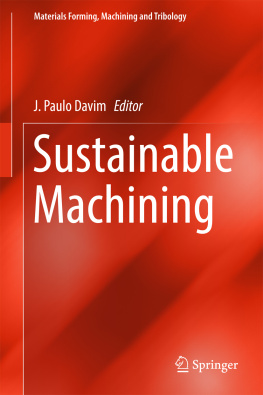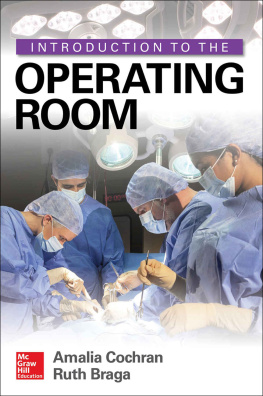CNC Machining Handbook
About the Author
Alan Overby received a B.S. in Electrical Engineering from Arizona State University. He has always had a hobbyist interest in CNC technology, and has owned, programmed, and operated several CNC routers and engraving machines on a professional level within the signage industry. Mr. Overby was co-owner of Custom CNC, Inc., a company that provided new and replacement controller systems to both individuals and original equipment manufacturers.
CNC Machining Handbook
Building, Programming, and Implementation
Alan Overby


Copyright 2011 by The McGraw-Hill Companies, Inc. All rights reserved. Printed in the United States of America. Except as permitted under the United States Copyright Act of 1976, no part of this publication may be reproduced or distributed in any form or by any means, or stored in a database or retrieval system, without the prior written permission of the publisher.
ISBN: 978-0-07-162302-5
MHID: 0-07-162302-7
The material in this eBook also appears in the print version of this title: ISBN: 978-0-07-162301-8, MHID: 0-07-162301-9.
All trademarks are trademarks of their respective owners. Rather than put a trademark symbol after every occurrence of a trademarked name, we use names in an editorial fashion only, and to the benefit of the trademark owner, with no intention of infringement of the trademark. Where such designations appear in this book, they have been printed with initial caps.
McGraw-Hill eBooks are available at special quantity discounts to use as premiums and sales promotions, or for use in corporate training programs. To contact a representative please e-mail us at bulksales@mcgraw-hill.com.
Information contained in this work has been obtained by The McGraw-Hill Companies, Inc. (McGraw-Hill) from sources believed to be reliable. However, neither McGraw-Hill nor its authors guarantee the accuracy or completeness of any information published herein, and neither McGraw-Hill nor its authors shall be responsible for any errors, omissions, or damages arising out of use of this information. This work is published with the understanding that McGraw-Hill and its authors are supplying information but are not attempting to render engineering or other professional services. If such services are required, the assistance of an appropriate professional should be sought.
TERMS OF USE
This is a copyrighted work and The McGraw-Hill Companies, Inc. (McGraw-Hill) and its licensors reserve all rights in and to the work. Use of this work is subject to these terms. Except as permitted under the Copyright Act of 1976 and the right to store and retrieve one copy of the work, you may not decompile, disassemble, reverse engineer, reproduce, modify, create derivative works based upon, transmit, distribute, disseminate, sell, publish or sublicense the work or any part of it without McGraw-Hills prior consent. You may use the work for your own noncommercial and personal use; any other use of the work is strictly prohibited. Your right to use the work may be terminated if you fail to comply with these terms.
THE WORK IS PROVIDED AS IS. McGRAW-HILL AND ITS LICENSORS MAKE NO GUARANTEES OR WARRANTIES AS TO THE ACCURACY, ADEQUACY OR COMPLETENESS OF OR RESULTS TO BE OBTAINED FROM USING THE WORK, INCLUDING ANY INFORMATION THAT CAN BE ACCESSED THROUGH THE WORK VIA HYPERLINK OR OTHERWISE, AND EXPRESSLY DISCLAIM ANY WARRANTY, EXPRESS OR IMPLIED, INCLUDING BUT NOT LIMITED TO IMPLIED WARRANTIES OF MERCHANTABILITY OR FITNESS FOR A PARTICULAR PURPOSE. McGraw-Hill and its licensors do not warrant or guarantee that the functions contained in the work will meet your requirements or that its operation will be uninterrupted or error free. Neither McGraw-Hill nor its licensors shall be liable to you or anyone else for any inaccuracy, error or omission, regardless of cause, in the work or for any damages resulting there from. McGraw-Hill has no responsibility for the content of any information accessed through the work. Under no circumstances shall McGraw-Hill and/or its licensors be liable for any indirect, incidental, special, punitive, consequential or similar damages that result from the use of or inability to use the work, even if any of them has been advised of the possibility of such damages. This limitation of liability shall apply to any claim or cause whatsoever whether such claim or cause arises in contract, tort or otherwise.
Contents
Preface
Using CNC, whether on a professional or hobbyist level, is not only an exciting process to be involved in but is also the direction manufacturing is heading. There are a great many facets and stages involved in the end-to-end process of understanding and implementing CNC, and, although there have been several books published on specific aspects or topics (such as G-code programming, building a CNC machine, etc.), there have been no books written that guide the reader through the overall process, that is, until now. It is not the intent of this book to replace any previously written information on this topic nor to delve into any particular area. However, by the time readers finish reading this book, they will have a solid understanding of the entire CNC process from a top-down end-to-end perspective.
More specifically, this book is intended for the following audiences:
Academic: This book will provide the instructor and students a very informative introduction into applied CNC, the various machines, and their uses, along with the necessary tools used in the process.
Business owner: The aspect of moving a small- to medium-sized business, or even a startup company, from a manually concentric manufacturing process into the accuracy and repeatability of what CNC has to offer, can be a daunting task. This book guides business owners in the proper direction to help them understand and decide the ins and outs of automating their manufacturing process. Furthermore, also discussed will be what to look forward to when growing future CNC-based operations.
Hobbyist: There are a great number of individuals interested in the understanding and technical aspects of CNC, but are not exactly sure where to beginwhat is absolutely required for the application at hand from both a hardware and software perspective and what is not. There are many free and low-cost software options to choose from that are listed for the reader to appropriately determine what is needed for their particular application.
Readers looking for an industry guide: This book is also intended to be used as a guide, showing the reader that there are certain industry standards within the field of CNC that should be adhered to. There are proprietary hardware and software systems for sale and this book advises the reader as to the pitfalls of using components and systems that are nonstandard. Furthermore, the reader is armed with the appropriate questions to ask the vendors when trying to determine the best approach to take.
Depending on who the reader has previously spoken with or what information they have read, this book will help to augment or clarify what is truly needed for your particular application. This information is to help arm you with the proper information rather than leaving you to rely on what a salesperson is interested in selling you. Often there are low-cost and even free software tools available. These will help you make the determination if certain hardware or software will satisfy your needs, before spending money where you may not need to.
Next page

